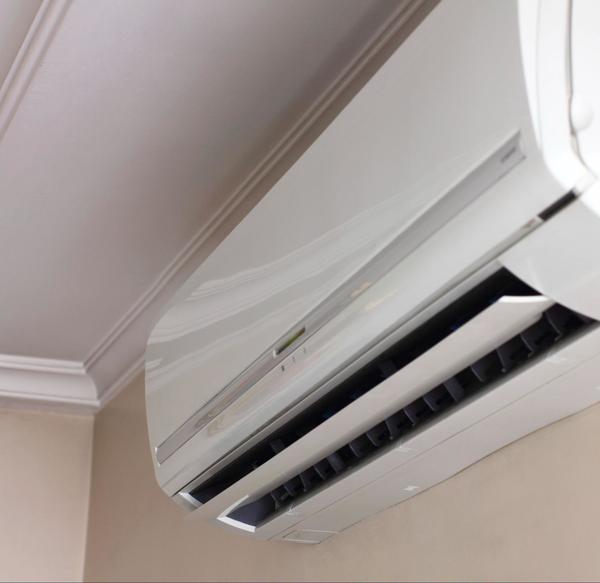What Size Ductless Heat Pump Do I Need?

An HVAC installer correctly sizing your ductless heat pump is crucial for many reasons.
If you’re considering a ductless heat pump (or several) for your home, you may be wondering which size of system you need.
Well, it’s a simple question with a complicated answer. You see, without sending a technician to your home to perform a load calculation, we can’t accurately tell you what size your ductless heat pump should be. Any estimate we’d give you here would likely be wildly inaccurate without an in-person estimate, which could cause potential problems down the road.
This article will cover what goes into sizing a ductless heat pump and why the proper size is essential. We’ll review the following topics:
Let’s start by looking at how to measure a ductless heat pump's size in the first place.
Want a Minneapolis-St. Paul pro to calculate the right size for your ductless heat pump? Call (651) 228-9200 or schedule an appointment online, and we’ll send a technician right over. We can also provide you with upfront pricing on the cost to install a ductless heat pump.
How We Measure Ductless Heat Pump Size (Capacity)
Many homeowners assume that the “size” of a ductless (mini-split) AC or heat pump refers to its physical dimensions or weight. Instead, the size of a ductless heat pump is a reflection of its heating/cooling capacity.
Manufacturers measure the cooling and heating capacity of a heat pump in British Thermal Units (BTUs). One BTU is the amount of energy required to raise one pound of water by 1° F.
Residential mini-split heat pumps have BTU outputs ranging anywhere from 9,000 to 60,000. The higher the BTU output of the unit, the more cooling/heating capacity it has (i.e., the “bigger” it is). You may also see the BTU output of a ductless unit expressed in tonnage. One ton equals 12,000 BTUs.
Why It’s Important To Get the Correct Ductless Heat Pump Size
In the beginning, we mentioned that giving an inaccurate sizing estimate could lead to problems down the road. We’ll explain why.
Why it’s bad to install an oversized ductless heat pump
Let’s say you purchase a ductless heat pump that’s oversized for the space you want to heat or cool. Because it has such a large cooling and heating capacity, the heat pump will cool/heat the room quickly and then shut off.
While this may not seem like a bad thing, it causes the unit to turn off and on frequently, possibly causing damage to internal components. Plus, it leads to hot and cold spots throughout the room because the heat pump doesn’t have enough time to circulate air properly.
Why it’s bad to install an undersized ductless heat pump
On the other hand, let’s say you purchase an undersized ductless heat pump. An undersized heat pump will constantly struggle to heat or cool your room to the desired temperature. As a result, you’ll experience higher energy bills because the unit runs longer than it should. Additionally, your heat pump may need frequent repairs as internal components wear out due to the longer heating/cooling cycles.
Getting a correctly-sized ductless unit will help you avoid these issues. Let’s look at how a professional can help you determine the correct size.
What a Load Calculation Is and Why It’s Essential to the Sizing Process
HVAC technicians use computer software to perform a load calculation. A load calculation helps the technician understand the heat gains and losses of a specific room (or all the rooms) in your home. After finding how much hot or cool air is needed to keep the space comfortable, the technician can recommend a ductless system with a matching cooling/heating capacity.
A load calculation involves complex mathematical equations that consider more than ten different factors specific to your room. Some of these factors include:
- The number of doors and windows in the room
- The proximity of the room to the kitchen
- The climate of you live in
- The square footage of the room
- The amount of sunlight the room receives daily
- The insulation levels of the room
- The height of the ceilings
- The type of flooring in the room
- The usual number of occupants in the room
- The type of roof your home has
- And more
Do these factors really make a difference? Absolutely.
Examples of how much these factors can affect sizing:
- If your ceilings are over 8 feet tall, you should increase your estimated BTU output by 20%.
- If the room is poorly insulated, you should increase your estimated BTU by 30%.
- If the temperatures in your area often exceed 90° F, increase your estimated BTU by 30%.
As you search for an HVAC contractor to install your mini-split system, beware of contractors who use rule-of-thumb estimates to determine size. One of the most egregious sizing errors is only looking at the square footage of the room. As you can see in the list above, square footage is only one of many factors determining a ductless system’s size.
Make sure the contractor you hire performs a complete load calculation. That way, you can rest assured your new ductless heat pump is the correct size.

Since 1918, MSP has provided the Minneapolis area with reliable HVAC installations.
Ready for a Minnesota Professional To Help You Size Your Ductless Heat Pump? Contact MSP.
Call (651) 228-9200 or schedule an appointment online today. Our expert technicians will perform a load calculation to help you determine the correct size for your new ductless system. We have over a century of experience providing Minnesotans with 5-star customer service, free installation estimates, and excellent craftsmanship.
Visit our ductless installation page for more information about what to expect when working with MSP Heating and Air.
